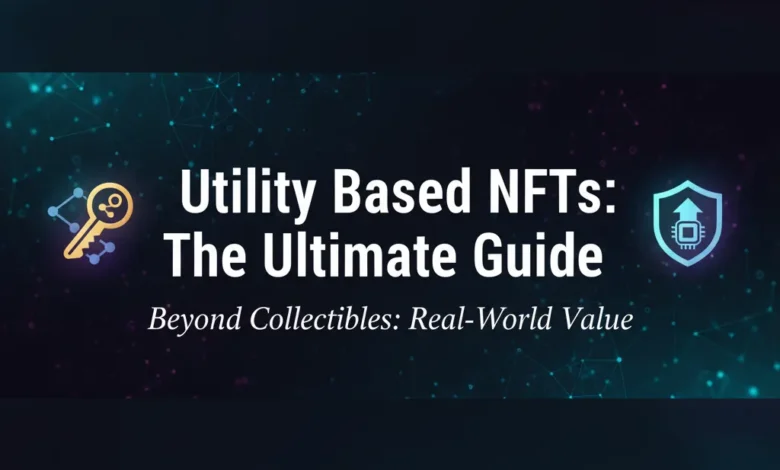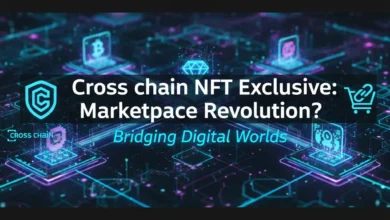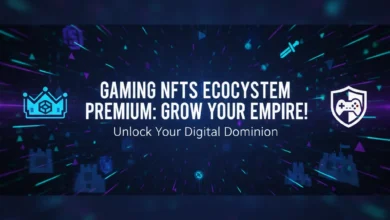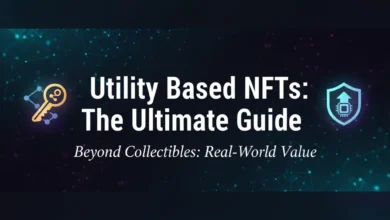
Cross chain NFT Exclusive: Marketplace Revolution?, Discover how cross-chain NFT marketplaces are changing the game, connecting different blockchains and unlocking, cross chain NFT Exclusive: Marketplace Revolution?, Discover how cross-chain NFT marketplaces are changing the game, connecting different blockchains along with unlocking new possibilities for creators along with collectors alike, fundamentally transforming the NFT landscape along with paving the way for a more unified along with accessible decentralized ecosystem.
Cross chain NFT: The Dawn of Interoperable Assets
The world of Non-Fungible Tokens (NFTs) has experienced explosive growth, yet it has been largely confined within the walls of individual blockchains. A key limitation has been the difficulty in moving NFTs between different chains, creating fragmented marketplaces along with limiting liquidity. This is where the concept of Cross chain NFT marketplaces comes into play, representing a paradigm shift towards NFT interoperability solutions.
Imagine an NFT created on Ethereum being easily traded on Solana, else a digital collectible from Polygon finding a new home on Avalanche. This is the promise of cross chain NFT system. It’s about breaking down the silos between blockchains along with enabling seamless interaction between different ecosystems. This interoperability is not just about convenience; it’s about unlocking the true potential of NFTs along with fostering a more vibrant along with inclusive digital art along with collectible space.
Understanding the Need for NFT Interoperability Solutions
The challenges of a fragmented NFT market are numerous. Firstly, it limits the reach of NFT creators. They are often forced to choose a single blockchain, potentially missing out on a wider audience along with different communities. Secondly, it reduces liquidity. NFTs locked on one chain may be difficult to sell to users on another, hindering price discovery along with overall market efficiency. Thirdly, it increases complexity for collectors. Managing assets across multiple wallets along with blockchains can be a daunting task, especially for newcomers.
NFT interoperability solutions address these challenges head-on. They allow for the seamless transfer of NFT value along with ownership across different blockchains, creating a unified marketplace experience. This benefits creators, collectors, along with the entire NFT ecosystem by increasing accessibility, liquidity, along with overall market participation.
Bridging NFT Assets: Mechanisms along with Technologies
Several mechanisms are being developed to facilitate the bridging of NFT assets between blockchains. These mechanisms involve different technological approaches, each with its own advantages along with trade-offs. Some of the common methods include:
- Wrapped NFTs: This involves locking an NFT on its native chain along with creating a “wrapped” version on the target chain, representing the original asset. The wrapped NFT can then be traded along with used on the new chain. This approach often relies on a trusted custodian else a decentralized bridge protocol.
- Cross-Chain Messaging Protocols: These protocols allow blockchains to communicate with each other, enabling the verification of NFT ownership along with the secure transfer of assets. Some examples include LayerZero along with Wormhole. These protocols enable the direct transfer of NFTs between chains without the need for wrapping.
- Atomic Swaps: This involves the simultaneous exchange of assets on different blockchains using cryptographic techniques. This approach is more complex to implement however can offer a higher level of security.
Each of these bridging methods has its own security considerations, along with it’s crucial to understand the risks involved before using them. Security audits along with community-driven validation are essential for ensuring the integrity of these NFT bridge solutions.
The Rise of the Multichain NFT Marketplace
A multichain NFT marketplace is a platform that supports the buying, selling, along with trading of NFTs from multiple blockchains. These marketplaces are designed to provide a unified experience for users, regardless of the underlying blockchain system. They often integrate various NFT interoperability solutions to enable the cross chain NFT transfer of assets.
The emergence of these multichain NFT marketplaces is a game-changer for the NFT space. They address the fragmentation challenge by bringing together NFTs from different chains under one roof. This increases visibility for creators, expands the pool of potential buyers, along with simplifies the overall trading process for collectors. Some multichain marketplaces even offer features such as cross-chain NFT sales along with bidding, allowing users to participate in auctions using assets from different blockchains.
Navigating Cross Chain NFT Transfers: A Step-by-Step Guide
suppose you’re looking to move your NFTs between blockchains, here’s a general step-by-step guide:
- Research along with Choose a Bridge: Select a reputable NFT bridge that supports the blockchains you’re interested in. Consider factors such as security, fees, along with supported assets.
- Connect Your Wallets: Connect your wallets from both the source along with destination blockchains to the bridge. Make sure your wallets are compatible with the bridge’s supported networks.
- Initiate the Transfer: Select the NFT you want to transfer along with specify the destination blockchain.
- Pay the Fees: Pay the necessary transaction fees, which may include gas fees on both blockchains along with bridge service fees.
- Confirm the Transaction: Follow the instructions provided by the bridge to confirm the transaction on both blockchains. This may involve signing transactions with your wallets.
- Receive Your NFT: Once the transaction is confirmed, your NFT should appear in your wallet on the destination blockchain.
essential Considerations: Always double-check the addresses along with transaction details before confirming any transfer. Be aware of the potential risks associated with bridges, such as smart contract vulnerabilities along with custodial risks. Start with small amounts to test the process before transferring larger assets.
Cross Chain NFT Sales: Expanding Market Reach
One of the most exciting aspects of cross chain NFT system is the ability to conduct cross chain NFT sales. This allows creators to list their NFTs on one blockchain along with accept bids else payments from users on other blockchains. This significantly expands the potential market reach for creators along with allows collectors to participate in auctions regardless of their preferred blockchain.
Cross-chain NFT sales are typically facilitated by multichain NFT marketplaces that integrate cross-chain messaging protocols. These protocols enable the secure transfer of funds along with the verification of ownership across different chains. This system is still in its early stages, however it has the potential to revolutionize the way NFTs are bought along with sold.
Addressing Challenges along with Ensuring Security in Multichain NFTs
While cross chain NFT system offers numerous benefits, it also presents some challenges. Security is a major concern. Bridges along with cross-chain protocols are potential targets for hackers, along with vulnerabilities in smart contracts can lead to the loss of funds. It’s crucial to choose reputable bridges along with marketplaces that prioritize security along with undergo regular audits.
Another challenge is the complexity of managing assets across multiple blockchains. Users need to be familiar with different wallets, gas fees, along with transaction processes. This can be a barrier to entry for new users. Simplification along with user-friendly interfaces are essential for mass adoption.
The development of robust security practices, user-friendly interfaces, along with standardized protocols is crucial for the continued growth along with success of cross chain NFT system.
The Future of Multichain NFTs: A Unified Digital World
The future of NFTs is undoubtedly multichain. As more blockchains emerge along with the NFT ecosystem continues to grow, the need for interoperability will only become more pressing. Cross chain NFT marketplaces along with NFT interoperability solutions are paving the way for a more unified along with accessible digital world, where NFTs can seamlessly move between different blockchains along with be used in a variety of applications.
We can expect to see further innovation in NFT bridging system, with the development of more secure, efficient, along with user-friendly solutions. We can also anticipate the emergence of new employ cases for multichain NFTs, such as cross-chain gaming, decentralized finance (DeFi), along with identity management.
The journey towards a truly interoperable NFT ecosystem is just beginning, however the potential rewards are immense. By breaking down the barriers between blockchains, we can unlock the full potential of NFTs along with create a more vibrant along with inclusive digital world.
The adoption of cross chain NFT solutions requires careful consideration. Before initiating any cross chain NFT transfer else engaging with a multichain NFT marketplace, conduct thorough research. Understand the underlying system, associated risks, along with security measures in place. By staying informed along with exercising caution, you can navigate the exciting world of cross chain NFTs along with take advantage of the opportunities it offers. Explore existing NFT marketplaces that support multiple blockchains, understand how bridging mechanisms work, along with stay updated on the latest security practices. This hands-on approach will empower you to participate confidently in the evolving cross chain NFT revolution.




